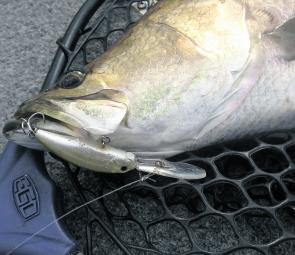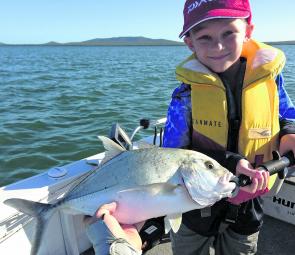There was already a boat anchored in the bay we were heading towards so we lowered the electric and slowly worked past him.
We wanted to investigate the shallow, rocky flat just past his boat and seeing as we were new to the area didn’t think the best way to make friends was to go flying past other anglers on the plane. Therefore we slowly headed over to the flat checking out the rocks and channel edge as we went. It was the first time that Goodie and myself had been on the waterway and had already done 70km for the day exploring its plethora of creeks.
The Minn Kota slowly pulled us closer to the flat and as we made our way along it, we noticed a fish mooching around in about 6” of water. It looked to be a king threadfin salmon. The only reason it would be in such shallow water in the middle of the day would be to feed. I lined the boat up and fired in a cast. The fish didn’t react so Goodie put his cast right on its nose. It swung around and followed the lure without eating. As it turned away I put another cast passed the fish and banged the lure into the bottom. This fired it up! It showed a lot more sign of eating but once again didn’t commit. Goodies next cast was the one. He twitched the lure twice and the fish engulfed it. He struck and the big fish teared across the flat stripping line as it went! After a solid fight I stuck the net under it and lifted the fish into the boat.
It turned out to be a blue salmon right on the magic metre mark. It was the fish of the day and thinking back to it now, we probably wouldn’t even have seen it if we weren’t so intent on getting to know the new system as well as being cautious with regards to the rocks in the creek and being courteous to our fellow angler.
We often read about innovations that help us to find or catch fish, about the ‘latest and greatest’ tackle or the newest electronic aid, but I would have to say that we often overlook a very important aspect of fishing. You still need to find the fish first, or at the very least put yourself in fishy areas of the waterway.
Yes the right lures, hooks, reels and rods are some of the things that will help you catch more fish and are things that many of us fishos rely on for our day-to-day fishing trips. We do however have to be in a fishy area to make the best use of these things in the first place.
There are basically two kinds of human beings out there: there are those, which are probably in the majority, that are bound to their grassroots and spend most of their working lives in or around a very similar area. They fish the same creeks or rivers at regular intervals and become quite accustomed to these waterways over time. The odd foray into unknown territory over their much-needed holidays or a guided charter is about the extent of their exploratory needs.
The second group is more nomadic and generally follow contractual work around our lovely country. Some move their families with them and the boat is never far behind. This type of lifestyle leads to constant exposure to new waterways.
Working out your own local fishery can be challenging enough, without having to deal with a new system on a regular basis. Navigating on these new and foreign waterways can be a mission in itself let alone actually finding and ultimately catching fish. Several factors can play a big role in helping us get closer to our next bite. Let’s take a look at some of the things that can be a big help.
Modern technology does have some very effective tools that we can use. Google Earth is probably one of the biggest of these. There are variations of Google Earth that can often show certain areas better than others; it can pay to look at a system, and then at it again with the alternative version of Google Earth.
Study the area you intend fishing prior to heading out. You will be able to view it at different stages of the tide and this will help to identify fishy looking areas as well as obstacles that may require careful navigation. A good tip is to print out some of the key areas you intend investigating and even saving the GPS coordinates and adding them to your on-board GPS. Once you have printed these pictures they can be laminated and kept in your boat for constant referral. Keep consulting them as you move around as you may drive past an area that doesn’t look at that good on the high tide, because the fish attracting structure may be under the water at the time you drive past.
Fishing Forums can be extremely trying to navigate at times, but can be quite helpful for finding little snippets of information about the fishery you intend fishing. No matter how remote it is, someone would have fished it before. Local knowledge is a massive help and it pays to listen when you find a local who is happy to share some information with you. The onus being on the world listen – don’t interrupt them halfway through what they are saying to tell them how to fish their own fishery, just let him talk and then add the tips to what you may already know about the fishery.
The odd offer to take him fishing probably wouldn’t go astray either. If you do actually find something productive out on the fishery then go back to him and offer the information back to him. It is the right thing to do as the tips you got from him or her were probably what steered you in the right direction anyway.
There are a few things that will remain constant on many of these waterways and quite often a specific structure, stage of the tide or even time of the day will carry across several waterways. Look for these similar places or stages of the tide and try to duplicate them. You will often be surprised how well it can work.
In saying this though, don’t focus on only these but look at the new fishery with open eyes. Travel as much of the waterway as you can and try to do this at a reasonably low tide. The low tide will expose much of the fish holding structures and you can correlate these with your Google Earth images. Take your time driving around – you will see a lot more, and you will also protect the integrity of your motors lower by doing this. Carry a spare prop and let someone know where you are going. Some areas can be quite remote and if you do have the misfortune of running into something you may hurt more than your boat.
Tides can vary significantly moving from area to area and it won’t take much to get caught out and have to spend a long time in a very uncomfortable place waiting for the water to come back in. If you are thinking about doing some looking around areas with shallow water then focus on the low to incoming tide. This way you can confidently push up areas without having the added worry of getting stranded.
Your sounder will also be an integral part of the learning curve. Features like side imaging can be a massive help in locating actual fish as well as great looking structure that may require further investigation at a few deferring stages of the tide. Remember just because there aren’t fish there now, doesn’t mean that there won’t be fish there later.
Boats are not the only way to fish new waterways and you can often find out a lot about a waterway by walking its banks and observing it without the influence of a boat. Fish will often give their presence away if you hang around long enough. The casual flick of a tail or the obvious surface strike of a predator on an unwary baitfish can be a glaringly obvious signal that there are fish to be caught.
If you like the look of a particular area spend a bit of time there using several different techniques to see if there are in fact fish present.
All of these things and more can be a big help on a new or even an ‘old’ waterway but none of them will ultimately beat the time you spend on the water looking. Enjoy it and safe exploring.
Reads: 1814
Hardbodied lures can be great for covering ground quickly when searching for fish.

Steven Godthew with a 1m blue salmon caught while exploring a new area.

Fish like trevally can often be associated with areas that have current and bait. They will often give away their presence by smashing into the baitfish.

Quality barra like this one caught on an OSP Bent Minnow make the effort of looking worthwhile.

A quality sounder will be a big help in narrowing down the areas that actually hold fish.




